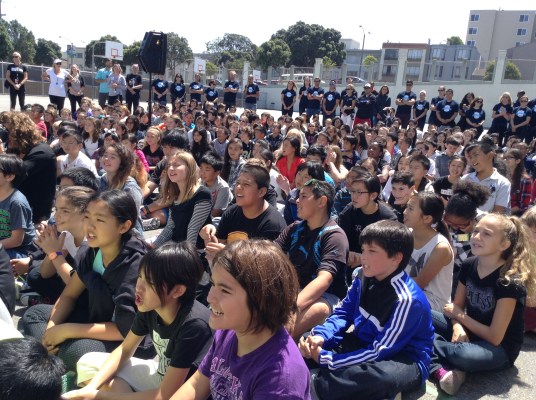As San Francisco’s population rapidly changes with an influx of new tech money and workers, a big question is what happens to the city’s K-12 schools and what tech’s ultimate influence on local education will be. Will tech’s presence improve public schools or bypass them by funneling even more students and wealth into pricey private schools?
The answer is a little bit of both.
Salesforce CEO Marc Benioff and the company’s foundation made a $6 million commitment today to the San Francisco Unified School District. That may be small relative to the more than half a billion dollars the school district plans to spend for the coming year but it will help them pilot a new computer science curriculum for the middle schools, give $100,000 to principals at 21 schools to spend at their own discretion, and give 14 full-time coaches and teachers for STEM (or science, technology, engineering and math). Zynga is also coming in as a partner to co-host game design workshops.
“It’s great to write a check,” Benioff said today in front of a crowd of sixth graders at Presidio Middle School. “But money alone doesn’t help schools. What helps schools is all of us embracing our schools, our school board and our great superintendent.”
“Do you guys like iPads? Have you seen more iPads around school lately?” Benioff asked the students.
“No!” they responded.
“That’s because we got you books,” Benioff replied, in what seemed like an obvious rebuke to the Los Angeles Unified School District’s disastrous $1.3 billion foray into giving out 700,000 iPads to students and teachers.
The district’s superintendent Richard Carranza pointed out that the donation is not conditional.
“If you listen to what Mr. Benioff says, they’re investing in our schools with the only return expected being a great education,” Carranza said. “So when they say there are no strings attached, it’s not like they’re giving a donation and you have to do X, Y and Z.”
Other tech philanthropists like Microsoft’s Bill Gates and Mark Zuckerberg have faced criticism for their approach to educational philanthropy — Gates, for his nationwide push for states to adopt a Common Core curriculum, and Zuckerberg, for a $100 million donation to the Newark, New Jersey school system that ended up largely being spent on consultants.
The Benioff, Salesforce and SFUSD donation is measured and cautious, and much smaller. The company has been working with the district for three years, and their employees have committed to volunteering at 20 local schools.
It is a tough time for public schools in the region. There is a nationwide teacher shortage, which is being more acutely felt here in the Bay Area and California because teachers’ salaries aren’t keeping up with the escalating cost of housing. Teacher salaries start at around $50,000 and head toward a median of about $69,400, while the city’s median rent sits at $3,880 per month.
A few weeks before the school year started, San Francisco’s public school district had to scramble to fill about 50 teaching slots. Across the bay, Oakland’s public schools, which open today, had 77 teaching positions open as of two Fridays ago. The district is now considering developing affordable housing dedicated to teachers on a city-owned parcel of land by Lake Merritt. Some longtime political players in the city like the Tenderloin Housing Clinic’s Randy Shaw have suggested that tech philanthropists step in to support rental subsidies or housing for public school teachers. Because it costs $600,000 to 800,000 to build a new housing unit in the city, or $300,000 to $400,000 to acquire an existing rent-controlled one, that would be extremely expensive.
But tech workers and donors are still influencing both the public and private ends of the schooling system in the city in smaller ways. On the public side, Tyson Daugherty, who founded a non-profit called MissionBit that teaches computer science in SFUSD’s afterschool programs, created a foundation dedicated to Mission High School. After a very public conflict between Dropbox employees and local Latino children on a neighborhood soccer field last year, Dropbox “adopted” Mission High School as part of “Circle The Schools,” an education-focused volunteering program put on by Ron Conway’s sf.citi non-profit.
On the private side, tech donors and workers have been extremely active as well. Billionaires like Steve Jobs’ widow Laurene Powell Jobs, Zuckerberg and his wife, physician Priscilla Chan, along with other philanthropic organizations covered half of the $100 million funding round for Altschool, a venture-backed school started by former Googler Max Ventilla that charges about $20,000 a year in tuition. They are set to run six schools in the city by next year, and are opening locations in Palo Alto and Brooklyn, New York. Other tech leaders like Abdur Chowdhury, who was Twitter’s chief scientist, put together another city private school called AltaVista.
The bigger question is where will tech workers send their kids?
San Francisco’s public and private enrollments reflect a multi-decade trend in California of increased market share for private schools. About one-third of the city’s 80,000 school-age children are in private schools. At least 15 different private schools have opened up in the last six years, and enrollment in these institutions has risen by 4,000 students since 2009.
Meanwhile, public school enrollment — an important raw metric used to determine state funding for the district — has remained flat.
